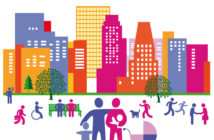Liveability and creating healthy communities will be the focus of future cities according to international sustainability experts
 Katie Swenson, a US-based leader in sustainable design for low-income communities, emphasised the importance of well designed, sustainable and affordable housing.
Katie Swenson, a US-based leader in sustainable design for low-income communities, emphasised the importance of well designed, sustainable and affordable housing.
Speaking at the recent Green Property Summit, Swenson argued that housing people and creating engaged communities not only has good social outcomes, but also saves a city money.
“Failing to do so means you will be engaging with this problem via your health and social services. Therefore, the role our buildings play in creating healthy, engaged communities has far-reaching social consequences.
“For the homeless, when you design a home that is beautiful and well suited, 98 per cent remain stably housed. This indicates there are health benefits to how and where we live. This is a consideration for the property industry.”
Swenson outlined her work for Enterprise Community Partners and the establishment of the Green Communities Criteria, the only national green building standard with direct applicability to affordable housing.
“Low-income communities experience disproportionately high rates of obesity, heart disease, diabetes and mental health issues.
“The Green Communities Criteria, which is a national green building standard, harnesses the power of design to improve residents’ health through “Active Design” requirements. This can include simple, cost-effective measures like improving stairwell access and visibility.
“We also promote healthy neighbourhoods, rather than just buildings. Access to services around a building are also important, and help create a happy, engaged community where people want to live.”
Summit speaker Davina Rooney, from Stockland Australia agreed, suggesting that we need to plan our future cities better to improve health and liveability.
“Obesity has a post code. The urban planning we do now, and the infrastructure we put in place will have a direct impact on the health of our children.”
American guest speaker Paul Rode also emphasised the importance of using technology to design, plan and connect our cities.
“Ten years ago, green design was all about energy efficiency as the cost of utilities was going up. Today, technological innovation means utility costs are declining. Now, green development is about liveability and creating communities and improving existing buildings.
“Cities of the future will be neighbourhoods connected by high speed internet, which links all the systems needed to support these communities.
Rode’s advice to New Zealand: “Make sure your buildings are better integrated into the site. Your street and traffic flows are not coordinated with pedestrians, it’s crazy walking around here.”
Keynote speaker Dr John Keung, CEO of Singapore’s Building, and Construction Authority (BCA) made the case for more government leadership in sustainable building. “Government must walk the talk.”
Andrew Eagles, CEO of the Green Building Council launched a policy position paper at the conference.“Better buildings and homes mean a better quality of life. It’s time to have a conversation about the built environment in New Zealand.”
“Working with industry and government to set out a trajectory for the built environment will provide certainty for the construction and property sector and greater productivity and better outcomes for New Zealanders,” Eagles says.
To energise the private sector towards green sustainability, Keung suggested greater financial incentives. “It is the classic carrot and stick approach. We set the minimum standard. However, if a developer reaches the higher targets, they get additional funding support or space to develop.”
Peter Mence, Chief Executive, Argosy Property Limited and national president, Property Council New Zealand, called on the property industry to do more.
“As a property industry, we must manage our resources reasonably.
“Personally, I do not believe the industry is moving fast enough, we need to lift our game.”
In his closing address to the summit, Property Council Chief Executive, Connal Townsend agreed.
“We all need to get on board and create sustainable, green buildings that people want to live and work in.” he said.
The summit was a joint event by the New Zealand Green Building Council (NZGBC) and Property Council New Zealand.




